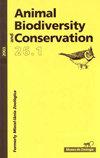迈向野生动物粪便样本的高通量分析
IF 1
4区 环境科学与生态学
Q3 BIODIVERSITY CONSERVATION
引用次数: 3
摘要
对野生动物粪便样本进行高通量分析。高通量测序为分子生态学和保护研究提供了新的可能性。然而,其潜力尚未被充分利用,用于自由放养动物的非侵入性研究,例如基于粪便的研究。高通量测序可以对短DNA片段进行测序,并可以以低成本同时对大量样本和标记物进行基因分型。高通量基因分型在野生动物粪便样本中的应用受到了几个劳动密集型步骤的阻碍。我们评估了可以为其中两个步骤提供更高吞吐量的替代方案:样本采集和DNA提取。两种不同的野外采样和七种不同的DNA提取方法在灰狼(犬狼疮)粪便上进行了测试。基因分型成功率差异很大。基于表面拭子的现场采样方法比从粪便碎片中提取的效果差得多。此外,在DNA提取步骤中还有很大的改进空间。协议的优化可以带来更高效、更便宜和更高吞吐量的无创监测。选择合适的标志物对提高基因分型成功率仍然至关重要。。本文章由计算机程序翻译,如有差异,请以英文原文为准。
Towards high–throughput analyses of fecal samples from wildlife
Towards high–throughput analyses of fecal samples from wildlife. High–throughput sequencing offers new possibilities in molecular ecology and conservation studies. However, its potential has not yet become fully exploited for noninvasive studies of free–ranging animals, such as those based on feces. High–throughput sequencing allows sequencing of short DNA fragments and could allow simultaneous genotyping of a very large number of samples and markers at a low cost. The application of high throughput genotyping to fecal samples from wildlife has been hindered by several labor–intensive steps. We evaluate alternative protocols which could allow higher throughput for two of these steps: sample collection and DNA extraction. Two different field sampling and seven different DNA extraction methods are tested here on grey wolf (Canis lupus) feces. There was high variation in genotyping success rates. The field sampling method based on surface swabbing performed much worse than the extraction from a fecal fragment. In addition, there is a lot of room for improvement in the DNA extraction step. Optimization of protocols can lead to very much more efficient, cheaper and higher throughput noninvasive monitoring. Selection of appropriate markers is still of paramount importance to increase genotyping success..
求助全文
通过发布文献求助,成功后即可免费获取论文全文。
去求助
来源期刊

Animal Biodiversity and Conservation
农林科学-动物学
CiteScore
2.00
自引率
0.00%
发文量
21
审稿时长
>12 weeks
期刊介绍:
Animal Biodiversity and Conservation (antes Miscel·lània Zoològica) es una revista interdisciplinar, publicada desde 1958 por el Museu de Ciències Naturals de Barcelona. Incluye artículos de investigación empírica y teórica en todas las áreas de la zoología (sistemática, taxonomía, morfología, biogeografía, ecología, etología, fisiología y genética) procedentes de todas las regiones del mundo. La revista presta especial interés a los estudios que planteen un problema nuevo o introduzcan un tema nuevo, con hipòtesis y prediccions claras, y a los trabajos que de una manera u otra tengan relevancia en la biología de la conservación. No se publicaran artículos puramente descriptivos, o artículos faunísticos o corológicos en los que se describa la distribución en el espacio o en el tiempo de los organismes zoológicos.
 求助内容:
求助内容: 应助结果提醒方式:
应助结果提醒方式:


